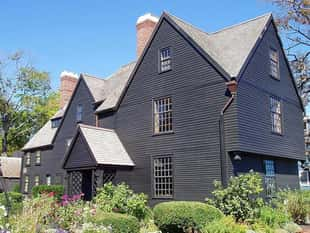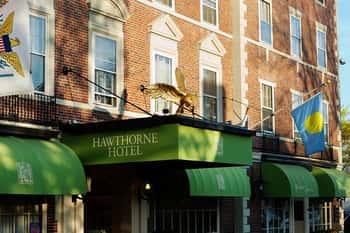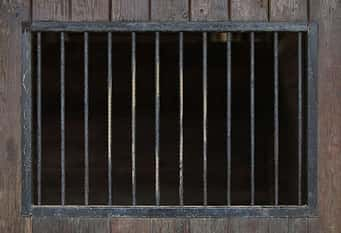“This was the field where superstition won her darkest triumph [...] the high place where our fathers set up their shame, to the mournful gaze of generations far remote. The dust of martyrs was beneath our feet. We stood on Gallows Hill.”
- Nathaniel Hawthorne, Alice Doane’s Appeal, 1835
Almost two hundred years ago, famed author Nathaniel Hawthorne spent his afternoons wandering the depths of Salem, Massachusetts’ most notorious execution place.
Each afternoon, after spending the mornings penning his latest novels, Hawthorne took his children and brought them to Gallows Hill, where nineteen victims were put to death for witchcraft.
Legend has it that the descendants of the accused families would pass on the secret location of Gallows Hill to the family members who came after them. Nathaniel Hawthorne was the direct great-grandson of Judge John Hathorne (note the missing “w”), the man almost wholly responsible for standing trial for the accused and sentencing innocent people for practicing the evils of witchcraft.
Since the days of Hawthorne’s leisurely strolls through the woods, the specific location of Gallows Hill has been lost to time. Historians argue over its location in the same way that others fight over the identity of the Holy Grail; others, merely curious, spend the odd day or two reenacting Nathaniel Hawthorne’s pilgrimage with their wee ones in tow.
But where does Gallows Hill exist? And do the souls of the accused still haunt its blood-stained land?
It seems that we may never know, but that hasn’t stopped us from trying to parse this grisly, ghostly information together.
In 1867, Reverend Charles Wentworth Upham painted Gallows Hill in a less than favorable light: “It is hard to climb the western side, impossible to clamber up the southern face. Settlement creeps down from the north, and has partially ascended the eastern acclivity, but can never reach the brink. Scattered patches of soil are too thin to tempt cultivation, and the rock is too craggy and steep to allow occupation.”
This quote is key to discovering the true Gallows Hill, which, for the larger part of a century, is believed to sit at the intersection of Hanson and South Streets.
In 1692, the process for witchcraft executions was rather formulaic. As the morning fog swirled around the tree trunks and flirted with the flowers, the victims (i.e., the very “witches” themselves) were removed from the Old Witch Gaol and forced into two-wheel oxcarts. The carts then rumbled down present-day Essex Street before the townspeople of Salem Village, before rolling to a stop somewhere “down the hill.”
According to local lore, the condemned were then hanged from locust trees before being tossed into a ditch--their burial place, as it was then illegal to give proper Christian burials to those who acted decidedly un-Christianlike. More recently, historians have claimed that the locust trees hangings were nothing but a rumor, and that the victims were actually hanged from ladders (or traditional gallows). It seems unlikely that the locust trees were at all strong enough to uphold bodies.
Author Frances Hill in Hunting for Witches claimed, “When the ladder was pushed away from whatever it was leaning on, they died a slow, painful death. But whether the ladder was supposed by a branch or a scaffold, the sources [do not say.]”
Historian Suzanna Saville believes otherwise. “The hill itself does not seem a very promising location when you get right down to it,” she wrote in her book, Hidden History of Salem.
Saville gathered her information from more contemporary sources. In her book, she references Robert Calef, who argued, “The cart, going to the hill with these eight to execution was for some time at a set [stuck]; the afflicted and others said that the devil hindered it.”
But what of the crevice?
The legend goes that after the hangings, including those from the Witch Trials. the sheriff (generally George Corwin) would have his men throw the lifeless bodies into a ditch, or a crevice. And the hangings themselves would have been performed outside of the city limits. At Gallows Hill (or at least, where many assume it to be) there is no appropriate ditch that the bodies would have been put.
It’s said that in the dead of night, families of the condemned would climb into their boats (canoes) and sail for Gallows Hill. There, they would gather their dead loved one and place them in the boat, traversing down the river until they reached their homestead and gave the accused a proper burial. Rebecca Nurse, one of the nineteen executed victims, exists as an example that the families did this.
In 1921, historian Sidney Perley made a startling discovery. While the site of Gallows Hill did not offer a crevice, nor even sound terrain to haul up the two-wheel oxcarts, there was a smaller hill nearby that fit the description perfectly.
Moreover, this smaller hill had a perfect view of across the river. This proved Perley’s assumption that this hill was the actual Gallows Hill, as records existed that Puritan John Buffum and his family could watch the executions from their house across the waterway. Based on Perley’s findings, an even closer house existed: John Maccarter’s.
Four months after the infamous trials, Maccarter attempted to sell his house and it sold for dramatically less than what it should have--according to Suzanne Saville.
Unfortunately, the North River does not intersect here any longer--in fact, it’s been mostly paved over and converted into part of Salem proper.
Today, the Gallows Hill that most people are aware of is nothing but . . . a baseball diamond. Yes, it’s true.
But up on that baseball diamond, and the children’s park that surrounds it, bone fragments have allegedly been found there. Naturally, the debate ensues on whether these skeletal remains belong to the 1692 witch trial victims.
According to the Peabody Essex Museum, who reported their findings to Ghosts of Salem author Sam Baltrusis, “Bone fragments have been found. But we’ll never really know what they are from.”
An unearthed record from the late 18th century delivered news of a mass excavation found in the general area of Gallows Hill. Immediately, it was largely assumed that the remains had to be those of the condemned . . . Only, the record also made note of a piece of coffin found in the mix, and as many historians have since pointed out: the nineteen witchcraft victims were buried sans coffins.
Really, they weren’t even that “buried” at all.
There have also been claims that Phillip English, the husband of Mary, one of the accused, actually moved the remaining victims after their hangings. Where did he move them? Another subject up for debate, though it’s largely believed that the bodies were placed in a church cellar in Marblehead.
So, where is Gallows Hill and where are the bodies of the victims?
In January 2016, The Salem News announced something spectacular: “Nearly 325 years after 19 people accused of witchcraft were hanged in this city, a group of scholars has finally confirmed the place where they met their fate: Proctor’s Ledge.”
According to the seven scholars who formed The Gallows Hill Project, Proctor’s Ledge, first “discovered” by Sidney Perley in 1921, comprised the perfect placement for Gallows Hill.
As Emerson “Tad” Baker, a history professor at Salem State University, told the newspaper, “There was never really a ‘eureka’ moment. I think most of us--we’re talking about a number of scholars who were working on this--we knew Perley’s research was really good.”
The group worked diligently for five years, using court records, maps, aerial photographs and even some fancy ground-penetrating radar to bring the 1692 witchcraft hysteria.
While approximately one thousand records exist from the period, hardly any witness accounts of the hangings still exist. But one does, and it laid the foundation for the Gallow Hill Project’s discovery.
Historian Marilynne Roach made a great find while digging through the centuries-old records. It seems that in 1692, Rebecca Eames, another woman believed to be practicing evil witchcraft, was removed from her home in nearby Boxford. As her cart turned down Boston Street, she could see the gallows where they stood as she headed for Salem Village.
Later on that day, Eames found herself in a preliminary trial. According to the report, the magistrate asked Eames if she’d witnessed the execution that morning. Her response was that she had been at “the house below the hill” and that, yes, she’d witnessed the “folks” at their hangings.
“The house below the hill” was none other than John McCarter’s house, the same house Sidney Perley had found years earlier, and a house that stood all the way until 1890 at 19 Boston Street.
That site Rebecca Eames saw now has an address: 59 Boston Street. An address that just so happens to sit behind a Walgreen’s drugstore.
Salem Mayor Driscoll told CBS Boston, “[the Salem witch trials is] definitely a dark part of our history, an infamous time in Salem when people turned onto each other. I think we learned a lot of lessons and we’ve worked hard to overcome what happened in 1692.”
Currently, a memorial for the victims is in the works to be placed at Proctor’s Ledge, the final destination for nineteen victims in 1692.
For decades, especially with the growing popularity of ghost tours, talk of ghosts roaming Gallows Hill has made for a spooky story.
Though we now know that Gallows Hill (the “famed” spot for Gallows Hill) is not the true hanging site of the 1692 victims, tales of ghosts and hauntings have nevertheless pervaded Salem’s paranormal culture.
Salem Night Tour owner, Tim Maguire, informed author Sam Baltrusis that Gallows Hill has a dark history outside of the witchcraft hysteria. In fact, Maguire claims that Gallows Hill has been the site of multiple suicides, as well as truly inexplicable phenomena.
There have been full-bodied apparitions spotted within the woods. Disembodied voices shrieking in the middle of the night, so eerie that the startling sound sends chills racing down the spines of even the most unflappable people.
But still, people worry about demonic happenings at Gallows Hill.
In October of 1992, nearly two hundred people gathered together, all from various churches in the area. They desperately worried about the dark energy that stained Gallows Hill. The following day, The Salem Evening News claimed: “Before the formal program of singing and prayer began, a group of close to 100 gathered into a small, tight circle on top of Gallows Hill, raised their arms skyward and chanted, ‘The curse over Salem with witchcraft is broken.’ They then circled the town water tower on top of the hill, which is decorated with the drawing of a witch, and performed a ‘laying on of hands’ on the tower as a sign of spiritual healing.”
Respect for the dead, fear of the evils of witchcraft, and guilt for the slandering of the condemned has been a common reason why many believe Gallows Hill to be haunted. For many who visit, they are immediately consumed with a sense of foreboding dread. Ghost tour guides who once made the arduous trek up the hill with their guests no longer do so, convinced that something evil lurks in the depths of Gallows Hill. As one company put it, something occurs at the eerie spot and it’s not uncommon to see guests burst into tears upon entering the area.
Still, whether or not (and it’s most likely not) the spirits of the condemned still haunt the area, something is causing paranormal activity at the old Gallows Hill.
Strange sounds emerge from the area at night; knocking and thumping that wakes the neighbors from their sleep. And, of course, the full-bodied apparitions said to walk the grounds certainly don’t make for a leisurely stroll through the park.
Would you dare to visit Gallows Hill?
Today, the “old” Gallows Hill is a city park within Salem, and anyone can visit at any time. Beware, however, as the ghosts which haunt the park are not known to be particularly friendly and most tend to run hastily back the way in which they came.
For those interested in visiting the real Gallows Hill, be sure to find yourself at Proctor’s Ledge. While there are no accounting for the ghost stories there, it’s safe to say that Salem as a whole has enough ghosts to last 375 lifetimes.
One lifetime for every year which has passed the witchcraft hysteria in 1692.

One of Salem's most famous haunted houses

Spend a night in Salem's most haunted hotel

One of Salem's most haunted places